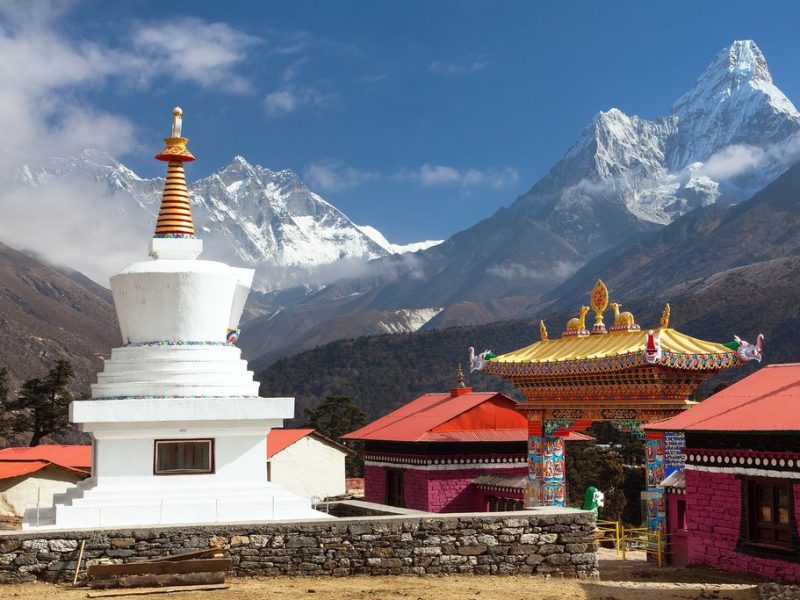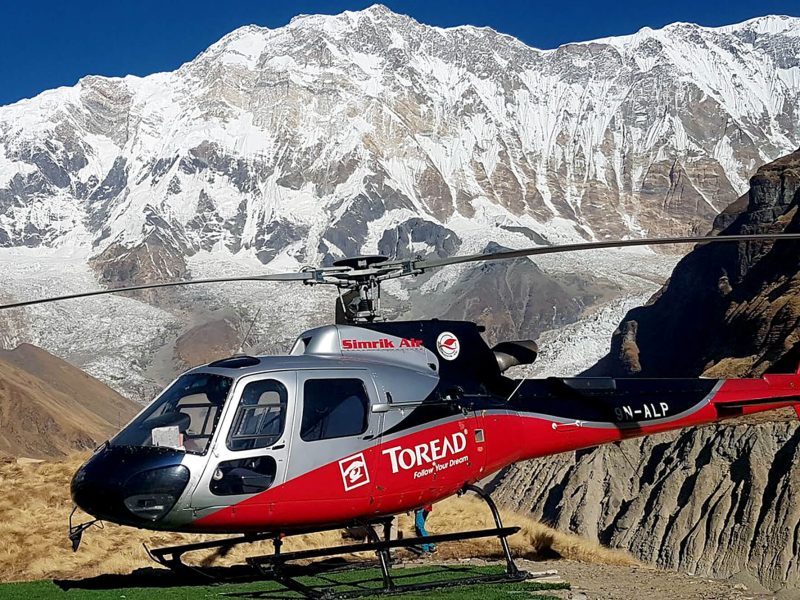Nestled like a hidden gem in the heart of the Khumbu region, the Tengboche Monastery Trek beckons adventurers with the promise of an extraordinary journey. This trek transcends the ordinary, weaving together the breathtaking tapestry of awe-inspiring landscapes and a profound cultural experience. As we embark on this mystical odyssey, we invite you to join us in unraveling the secrets of the Tengboche Monastery Trek—a pilgrimage of the soul amidst the towering peaks of the Himalayas. In this comprehensive article, we will traverse the scenic trails, unravel cultural highlights, and provide practical tips, ensuring your voyage is not just memorable but truly transformative.
Highlights of Tengboche Monastery Trek:
- Lukla’s Charming Gateway: Begin your adventure in Lukla, a picturesque town that serves as the gateway to the Tengboche Monastery Trek.
- Rhododendron Symphony: Traverse lush rhododendron forests, where vibrant blooms create a colorful carpet under the canopy.
- Sherpa Village Immersion: Experience the unique culture and warm hospitality of Sherpa villages along the trail.
- Iconic Peaks Panorama: Revel in panoramic views of Everest, Lhotse, and Ama Dablam, creating a breathtaking horizon.
- Sagarmatha National Park Exploration: Immerse yourself in the diverse flora and fauna of Sagarmatha National Park.
- Tengboche Monastery: Visit the Tengboche Monastery, a spiritual and cultural centerpiece with a stunning backdrop of snow-capped peaks.
- Suspension Bridge Crossings: Navigate thrilling suspension bridges, adding an element of excitement to your trekking experience.
- Rocky Mountain Terrain Challenge: Conquer rugged mountain terrain, testing your physical and mental endurance.
- Cultural Exchange: Engage with local communities, appreciating traditional architecture and the resilient spirit of Sherpa inhabitants.
- Wildlife Encounters: Spot elusive Himalayan Tahr and hear the melodious call of the Himalayan Monal, encountering unique wildlife along the way.
The Scenic Trail:
Our journey begins in Lukla, a gateway to the Khumbu region, where every step unfolds a new chapter in the grand narrative of this trek. The trail meanders through lush rhododendron forests, painting the landscape with bursts of color, and ascends gradually, revealing panoramic vistas of iconic peaks such as Everest, Lhotse, and Ama Dablam. Enveloped by the pristine beauty of the Sagarmatha National Park, the trail becomes a passage through nature’s gallery, with each turn presenting a postcard-perfect view. As we ascend, the rhythmic crunch of our footsteps on the mountainous terrain is accompanied by the distant murmur of glacial streams—a symphony of the Himalayan wilderness.
Cultural Highlights:
At the heart of this journey lies the Tengboche Monastery, a spiritual sanctuary perched at an elevation of 3,867 meters (12,687 feet). As we approach, the monastery emerges like a spiritual beacon against the backdrop of snow-capped peaks. Here, visitors are welcomed into a world where time seems to stand still—a place where monks clad in maroon robes engage in age-old rituals, and the scent of burning juniper incense hangs in the mountain air. The Tengboche Monastery is not just a stop along the trail; it is a living testament to the rich cultural heritage of the Khumbu region. Join us as we partake in the serenity of prayer flags fluttering in the Himalayan breeze and the mesmerizing sound of chanting echoing through the valleys.
The cultural journey extends beyond the monastery, allowing trekkers to interact with the local Sherpa communities. The trek becomes a conduit to understanding the Sherpa way of life, exploring ancient stupas, and witnessing the vibrant tapestry of traditional festivals. Engaging with the locals adds a cultural depth to the adventure, fostering a sense of connection with the land and its people.
The Scenic Trail:
The Tengboche Monastery Trek, a remarkable adventure that unfolds in the heart of the Himalayas, commences in the charming town of Lukla. From this point of embarkation, trekkers are immersed in a captivating journey that traverses a kaleidoscope of landscapes, ranging from dense rhododendron forests to quaint Sherpa villages and challenging mountainous terrain. This immersive trail not only offers a physical challenge but also promises a feast for the senses as it unfolds against the backdrop of the world’s most iconic peaks.
As the trail meanders through the lush rhododendron forests, trekkers are treated to a symphony of colors, with vibrant blooms creating a picturesque contrast against the verdant foliage. The fragrance of these blossoms fills the air, creating an enchanting atmosphere that accompanies adventurers on their upward ascent. The rhythmic crunch of leaves beneath sturdy trekking boots becomes a companion to the trekker, marking each step forward into the heart of the Sagarmatha National Park.
The trek gradually gains elevation, rewarding intrepid explorers with awe-inspiring panoramic views of towering peaks, including the majestic Everest, the formidable Lhotse, and the gracefully sculpted Ama Dablam. The distant snow-capped summits create a surreal horizon, inspiring a sense of wonder and humility in those fortunate enough to witness such breathtaking vistas.
Winding through Sherpa villages, trekkers have the opportunity to immerse themselves in the unique culture and warm hospitality of the local inhabitants. The traditional architecture of the villages, adorned with prayer flags fluttering in the mountain breeze, adds to the mystical charm of the journey. Engaging with the Sherpa communities along the way provides not only a cultural exchange but also a chance to appreciate the resilience and spirit of these mountain dwellers.
The rugged mountain terrain poses both a physical and mental challenge, making each step a testament to determination and endurance. Crossing suspension bridges over roaring mountain rivers and negotiating rocky paths, trekkers forge ahead, surrounded by the pristine beauty of the Himalayan wilderness.
Throughout the trek, the Sagarmatha National Park unfolds its treasures, showcasing a diverse range of flora and fauna. The elusive Himalayan Tahr might be spotted on rocky outcrops, and the echoing call of the Himalayan Monal, a resplendent pheasant, adds a melodic note to the trekking experience. The park becomes a living testament to the importance of conservation efforts in preserving this unique ecosystem.
Cultural Highlights:
The highlight of this trek is undoubtedly the Tengboche Monastery, a spiritual hub perched at an altitude of 3,867 meters (12,687 feet). This Tibetan Buddhist monastery holds immense cultural significance and is a center for religious ceremonies and festivals. Visitors have the chance to witness the monks performing traditional rituals against the backdrop of the Himalayas, creating a surreal and tranquil atmosphere.
The trek also provides opportunities to interact with the local Sherpa communities. Trekkers can experience the Sherpa way of life, explore their unique customs, and visit ancient stupas and prayer flags that dot the landscape. Engaging with the locals adds a cultural layer to the trek, making it a holistic experience that goes beyond the physical challenges of the trail.
Practical Tips for the Trek:
Acclimatization is Key: Given the high altitude of the region, acclimatization stops are crucial. Spend a day in Namche Bazaar and Dingboche to allow your body to adjust to the thin mountain air.
Pack Wisely: Pack layers to accommodate changing weather conditions. Quality trekking gear, a good pair of hiking boots, and a reliable backpack are essential for a comfortable trek.
Permits and Logistics: Obtain the necessary permits for the trek, including the Sagarmatha National Park entry permit and TIMS card. Additionally, plan your trek during the optimal seasons of spring (March to May) and autumn (September to November) for the best weather conditions.
Cultural Sensitivity: Respect the local customs and traditions. When visiting the Tengboche Monastery, adhere to any guidelines provided by the monks and maintain a respectful distance during religious ceremonies.
Some FAQs:
How difficult is the Tengboche Monastery Trek?
The Tengboche Monastery Trek is moderately challenging, suitable for trekkers with a moderate level of fitness. The trail includes both gradual ascents and descents, with some steep sections. Altitude acclimatization is important to mitigate the risk of altitude sickness.
What is the best time to trek to Tengboche Monastery?
The optimal times for the Tengboche Monastery Trek are during the pre-monsoon (spring) from March to May and post-monsoon (autumn) from September to November. During these periods, the weather is generally clear, and the temperature is moderate, offering the best trekking conditions.
Are permits required for the Tengboche Monastery Trek?
Yes, trekkers need both a Sagarmatha National Park entry permit and a Trekkers’ Information Management System (TIMS) card. These permits help in maintaining and conserving the natural and cultural resources of the region.
What is the duration of the Tengboche Monastery Trek?
The duration of the Tengboche Monastery Trek typically ranges from 8 to 10 days, depending on the chosen itinerary and starting point. This includes acclimatization days to adapt to the high-altitude conditions.
How do I get to Lukla, the starting point of the trek?
Trekkers usually take a short domestic flight from Tribhuvan International Airport in Kathmandu to Lukla Airport. The flight offers stunning views of the Himalayas, but weather conditions can affect flight schedules.
What are the accommodation options along the Tengboche Monastery Trek?
Accommodation along the trek consists mainly of teahouses and basic lodges in the villages. These provide a cozy and communal atmosphere, offering meals and a place to rest. It’s advisable to book accommodations in advance, especially during peak trekking seasons.
Are there any altitude-related challenges on the trek?
Yes, altitude-related challenges are common on the Tengboche Monastery Trek due to the high elevation. Trekkers should acclimatize properly, stay hydrated, and be aware of symptoms of altitude sickness, such as headaches and dizziness.
Can I do the Tengboche Monastery Trek independently, or do I need a guide?
While it is possible to trek independently, many trekkers opt for experienced guides for navigation, cultural insights, and safety. Guides also assist in obtaining permits and dealing with unforeseen challenges.
What should be pack for the Tengboche Monastery Trek?
Essential items include proper trekking gear, warm clothing, a reliable pair of hiking boots, a backpack, water purification tablets, a first aid kit, and any personal medications. Adequate layers are crucial to cope with varying temperatures.
Are there any alternative routes or side trips from Tengboche?
Yes, there are several side trips and alternative routes from Tengboche. Popular options include trekking to Everest Base Camp, Gokyo Lakes, or Ama Dablam Base Camp, allowing trekkers to customize their experience and explore diverse landscapes within the Everest region.
Conclusion:
The Tengboche Monastery Trek is a harmonious blend of natural beauty and cultural immersion. Whether you’re a seasoned trekker or a first-time adventurer, this journey promises an enriching experience that lingers in your memory long after you’ve descended from the Himalayan heights. Embark on this spiritual trek, and let the majestic landscapes and cultural treasures of the Khumbu region leave an indelible mark on your soul.


